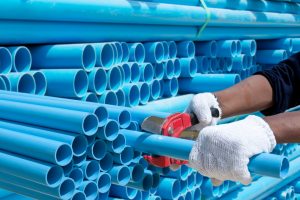 Pipes are what most people think of when they hear the word “plumbing.” This makes sense. Pipes are the essential part of what plumbing is, the transportation of water, sewage, and gas from one place to another.
Pipes are what most people think of when they hear the word “plumbing.” This makes sense. Pipes are the essential part of what plumbing is, the transportation of water, sewage, and gas from one place to another.
Since piping has a long history, there have been many different materials used to construct it, such as clay pipes back in the Bronze Age. (Clay, although better than Bronze Age era clay, was also common through the first half of the 20th century.) The piping materials used up to 1970 were usually cast iron, galvanized steel, and lead. These have fallen from favor, especially lead because of the toxicity it can add to fresh water. These materials are also prone to corrosion, which is why older homes often need to have water and sewer line replacements.
The modern plumber has superior piping materials available. Below are some of the materials we use for working on piping in Cincinnati, OH and the surrounding areas:
Copper
This is the metal of choice since the 1970s. Copper is durable, like steel, but unlike steel it is lightweight, more ductile, and corrosion-resistant. (It isn’t corrosion-proof, however; there are still some types of corrosion that can affect it. However, the usual corrosion from contact with the soil won’t affect copper.) Copper is a readily available metal, which makes it less expensive than steel and iron. When you combine that with how much easier copper is to work with and shape, it adds up to savings on piping jobs.
Chlorinated Polyvinyl Chloride (CPVC)
A type of plastic that improves on polyvinyl chloride (PVC). Both CPVC and PVC pipes and tubing are everywhere, and for some good reasons. CPVC can withstand an immense wide range of temperatures—more than PVC—making it ideal to use for hot water lines in a home. In fact, building codes often require using CPVC rather than PVC for hot water lines, since the former can tolerate up to 140°F. CPVC doesn’t corrode and can work for hot water lines, potable water lines, and drains. The material is cost-effective and can be put to a wide variety of uses.
Crosslinked Polyethylene (PEX)
The newest type of plastic to become common in plumbing applications, both residential and industrial. The huge advantages of PEX piping is its flexibility. A plumber can easily cut PEX pipes and fit them into any space without using joints and elbows. PEX also resists the buildup of scale from hard water and won’t suffer from pitted corrosion (the corrosion that can eat into a copper pipe). It doesn’t transfer heat the way copper does, making it ideal for hot water line use.
What type will my plumber use?
Here’s something important to know about these materials: this isn’t an all-or-nothing proposition. A plumber on a piping job will know which type to use for the situation, but when doing larger tasks like repiping, the plumber will use a combination of materials. Maybe a copper pipe for a long length of central piping, PEX for hot water lines into small spaces, and CPVC for drains and cold freshwater lines. When you arrange for plumbing services with our licensed and trained plumbers, you can trust you’ll always have the best (and correct) material put to use.
Ken Neyer Plumbing, Inc. is a full service plumbing contractor serving Greater Cincinnati and the surrounding Tri-State area Since 1972.
